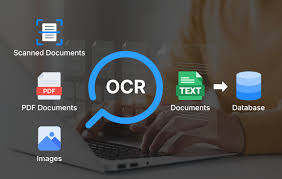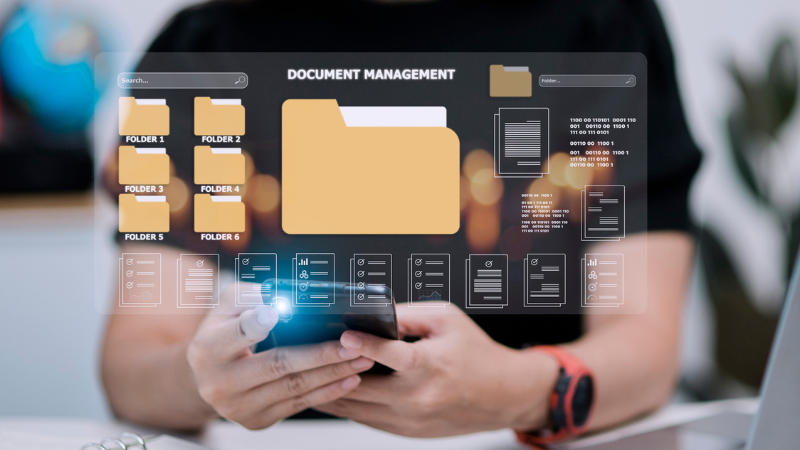AI-Powered OCR: Revolutionizing Document Digitization Across Industries
AI-Powered OCR is revolutionizing data management processes of the business world by ensuring automated conversion of printed/scanned/handwritten text into machine-readable editions. As opposed to the traditional OCR which was rule-based and constrained, AI-Powered OCR introduces intelligence and flexibility to the text recognition process and is faster, more accurate, and context aware.
There are also AI-Powered OCR that help organizations get rid of manual entry errors, save on time, and improve overall document processes. Be it invoices, legal forms, or the healthcare documents this technology has turned out to be a key to the digital transformation in all spheres.
OCR in the Digital Workflow with AI
The OCR that is powered by AI is at the center of most automation procedures, to overcome the physical-digital obstacle. It does not only identify characters, it also knows about structure, formatting and even context. This qualifies it as perfect smart document processing solutions.
Through AI-Powered OCR, work efficiency can be increased as bulk sets of files can be read in a matter of seconds, negating the actions of a manual check. It is compatible with ERP systems, CRMs and data analyses tools to allow easy automation of work flow.
Finance and Banking Finance and banking applications are driven by AI-supported OCR.
This is a game changer in the financial industry with the help of AI-Powered OCR. It simplifies invoice manuals, receipts, tax return, and cheques data input. It enables the financial institutions to digitalize thousands of records on a daily basis, which means the faster decision-making and regulatory compliance.
KYC (Know Your Customer) is also assisted by AI-Powered OCR as it recognizes the data of the customer in the ID documents, proof of address, and the bank statements, and accelerates the onboarding and minimizes the mistake.
How Healthcare AI-Powered OCR Can Save Lives
The OCR powered by AI is vital in the healthcare settings where data gathering can become a matter of life and death itself. It is applied in hospitals to convert handwritten prescriptions, patient intake forms, and lab reports to computerized records, forming well-organized digital health records (EHR).
OCR AI alleviates the administrative workload, improves access to data among departments and further improves patient care by making it possible to access records accurately and on time.
OCR-powered by AI in Logistics and Supply Chain
The AI-Powered OCR enhances the logistics sector by capturing information out of shipping labels, packing lists, and customs as well as freight bills. Document processing made automatic will decrease delays in customs and increase delivery schedue.
AI-Powered OCR is also useful in the efficient control of the inventory as it scans the forms in the warehouse and inserts real-time information into the logistics devices making it more efficient.
Legal and compliance AI-Powered OCR
The AI-powered OCR can be of benefit to law firms as it can scan lengthy documents, like contracts, affidavits, and any other litigation related document, and convert them to searchable and editable documents. Social studies Legal firms not only save the hours of work, but they also minimize chances of human error during reviews of documents.
AI-Powered OCR also contributes to e-discovery, contract management, and compliance audit, which makes sure that crucial provisions and legal references are not overlooked.
OCR in Education and Research
AI-Powered OCR assist instructors and scientists to computerize textbooks, manuscripts, archival files, and test sheets. This further enhances accessibility to students having learning disabilities and to search and share educational content.
Of course, OCR-AI is also used in digital libraries and scientific indexation, where AI-OCR has the most critical importance due to high efficiency and unacceptably low error rate when scanning thousands of pages of documents.
eCommerce and Retail OCR AI
OCR AI optimizes the end user experience and back end efficiency of eCommerce stores. It reads data off receipts, invoices, barcodes and shipping documents. This will make it automate return processing, inventory tracking and accounting.
Loyalty programs also have an application of the AI-Powered OCR, which allows scanning and processing physical coupons and invoices and providing a smooth customer reward experience.
Governments and Public Services Robotic Process Automation (RPA)
Using AI-Powered OCR can help public sector organizations to go digital and deal with the physical documents like taxes, permits and voter registrations. It also makes the departments such as immigration and licensing less cumbersome in terms of processing time.
OCR with the use of AI gives improved transparency and record keeping, thus governments can serve citizens in a faster, more efficient way.
Multilingual Text Recognition based on AI-Powered OCR
AI-Powered OCR does not apply to the English language only. It includes multilanguage support, such as complex scripts, arabic, Mandarin or devanagari. This is why it is perfect in the business involving documents that have to be in different foreign languages.
OCR supported by AI is frequently combined with translation software to offer cross-language document recognition that is essential to foreign compliance and communication.
Deep Learning and NLP AI-Powered OCR
Driven by deep learning and natural language processing (NLP), AI- Powered OCR does not only understand text, but meaning as well. To give you an example, it can tell a difference between a date and an invoice number by positioning and formatting.
The process of AI-Powered OCR training happens on large datasets and each new document translated successfully contributes to the increase in the accuracy of the system. This dynamic and evolving data structures capability attributes them ideal (perfect) to self learning.
REAL-TIME SUPER-RAPID OCR-AI
The use of AI-Powered OCR is starting to be applied to more of real-time uses like depositing checks using a mobile phone, checking parking meters, and travelers using ID. Using the cloud-based solutions, it is capable of processing documents in a few seconds and with a few human inputs.
Smartphone OCR with AI unleashes productivity among field workers and remote teams in all industries as they can digitalize data on the spot.
Compliance Data Privacy and OCR AI
AI-Powered OCR can assist organizations to remain compliant with regulatory laws such as GDPR, HIPAA, and PCI-DSS. It also facilitates the sensitivity of information such that recorded information is recorded correctly, secured correctly and only people with access are allowed to view them.
The AI-Powered OCR comes with built-in image redaction capabilities that automatically cover personal data in the scanned documents, which alleviates risks to privacy.
Scalability and Integration AI-Powered OCR
AI-Powered OCR platforms are scalable and can be connected to cloud storage (e.g., Google drive, OneDrive), databases, and automations (e.g. Zapier). No matter what type of business you run OCR can be easily incorporated in your business process whether startup or enterprise.
AI Powered OCR is developed with considerable APIs and SDKs that enables developers to integrate directly on to the current systems to smoothly automate workflow.
AI-Based OCR: shortcomings and restrictions
Even though AI-Powered OCR is powerful, it may encounter challenges when the scanned image is poor, when images are distorted, or when it has to deal with handwriting. But latest versions are constantly being updated with accuracy levels of more than 98% in most of these applications.
Preprocessing activities such as removing noise on the image, rectifying the skew of the image, and contrast improvements can better AI-Powered OCR performance.
Conventional OCR vs AI-Powered OCR
AI-Powered OCR is many times more versatile, precise, and multilingual than conventional OCR. It supports multilayered document format and context analysis, whereas standard OCR is inadequate with formats that are not standardized.
OCR with the help of artificial intelligence advances through machine learning, whereas the earliest OCR needs a manual update of the rules, and it is not that flexible.
Applications of AI-Powered OCR Down the Departments
Applications of AI-Powered OCR can be used department-wide- in HR (resume scanning, ID verifications) or in marketing (data extraction in printed surveys) or operations (form scanning). It is also company wide because of its flexibility.
The use of AI-Powered OCR will provide every department with trusted and digitized data, and this fact positively influences the work across many functions.
OCR o AI Small and Medium Business or Startups
The AI-Powered OCR can no longer be used only by large enterprises. SaaS-based OCR services and cloud-based OCR are cost-effective to those small business and startups interested in automating the paperwork, increasing productivity, and digitalizing documentation.
AI-Powered OCR could provide small businesses with a competitive advantage by giving them a chance to lower the overhead costs, accelerating the work.
Future Trends of OCR
AI-based OCR is moving toward enabling voice scanning, being paired with IoT devices (sync with smart scanners), and becoming completely automated by robotic process automation (RPA). One of the things in the future is the OCR on AR/VR in real-time.
In the near future, AI-powered OCR will be more affordable, mobile, and domain-specific (by utilizing models specific to a particular industry).



Leave a Comment